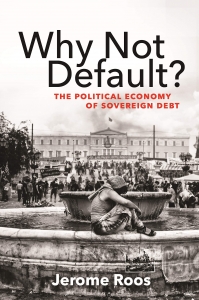In Why Not Default? The Political Economy of Sovereign Debt, Jerome Roos explores why sovereign defaults have been an undesirable last option by systemically unpacking the structural characteristics of the contemporary debt market. This is a fresh and painstakingly researched approach that raises vital questions for economists, political scientists and policymakers to address in the era of relatively low cost, yet mounting, sovereign debt, writes Aleksandr V. Gevorkyan.
Why Not Default? The Political Economy of Sovereign Debt. Jerome Roos. Princeton University Press. 2019.

In Why Not Default? The Political Economy of Sovereign Debt—a book based on his doctoral dissertation—Jerome Roos systematically unpacks the structural characteristics of the contemporary debt market. Leveraging analysis of historical evidence, the author proposes a theory of creditor structural power and high spillover costs of default, thereby answering the question in the book’s title. The book connects the global financial system with countries’ prospects for access to the international capital markets and economic development.
Why don’t nations, or in the adopted jargon, sovereign borrowers, simply default on their debt if that could minimise financial burdens? It would appear to be logical to renege on prior commitments when faced with macroeconomic deficiencies or a currency crisis and interruption of foreign exchange flows. Yet, as Roos argues, sovereign defaults have become less common. In fact, even going back in time, despite their higher frequency of occurrence compared to today, sovereign defaults were the undesirable last option.
There is much to discover and learn in this dense volume. The opening chapters are dedicated to what the author describes as ‘The Theory of Sovereign Debt’. This is then followed by a critical review of the history of sovereign defaults, starting with early Italian city states, continuing through the nineteenth-century restructurings and 1930s defaults. Before its concluding chapter, the bulk of the book is found in the most granular exploration of three cases across three lengthy parts focusing on Mexico (1982-89), Argentina (1999-2005) and Greece (2010-15).
The historical perspective on the evolution of debtor compliance is undoubtedly one of the distinctive strengths of this study. The problem of sovereign debt is neither new nor confined to computer-modelled technical fundamentals. And little here has been by accident and much is derived from the debt dealings and dispute resolutions of the accumulated past. This historical narrative is interplayed with political economy. Applied consistently throughout, this merger adds to the book’s credibility as the dispersed historical episodes are stitched together in a framework of three enforcement mechanisms of debtor compliance.
 Image Credit: ‘Let Greece Breathe’ event, London, 15 Feb 2015 (Sheila CC BY NC 2.0)
Image Credit: ‘Let Greece Breathe’ event, London, 15 Feb 2015 (Sheila CC BY NC 2.0)
So, why not default? The author argues that an institutional framework in the international capital markets of enforcement mechanisms securing creditors’ structural power over the borrower and the high spillover costs of default faced by the latter hold the key to the answer.
The first enforcement mechanism is the market discipline defined as ‘a product of private creditors’ capacity to inflict highly damaging spillover costs on a debtor’s economy by withholding further credit and investment in the event of noncompliance’ (17). Creditors’ ability to act uniformly against an autonomous borrower is paramount in this mechanism. Roos documents the progression of the global capital markets from a decentralised to a more concentrated scheme. The bond markets of the 1920s-1930s were highly decentralised and filled with small retail investors with limited ability to coordinate their actions as creditors. The state (on the creditor side) in those and earlier debt restructurings played an important role, with at least diplomatic guarantees. With time, as global financial markets transformed, following banking systems’ consolidation, there was a shift towards a concentrated organisation of capital markets imposing now a coordinated discipline upon the borrower. This, Roos argues, is the critical element of the structural power that contemporary creditors have over borrowing governments.
The second enforcement mechanism relates to the conditionality of lending, familiar to development economists and common in the cases of official creditors or multilateral organisations crisis lending. Moving from the cases of Mexico and Argentina to the recent Greek debt crisis, the book illustrates the rapid evolution of this mechanism. Along the way, the role of multilateral institutions, such as the International Monetary Fund (IMF), as a lender of last resort is strengthened. The official creditor states (and individual private investors), in turn, relied on IMF’s programme as a prerequisite assurance to re-engage with the borrower. The mechanism appears to gain effectiveness as the debtor faces minimal domestic financial self-sufficiency and no viable alternatives to borrow externally.
Finally, the third mechanism pertains to the ‘bridging role’ of local business and political elites in each debtor country advocating fiscal discipline and debt repayment. Roos sees this as a complementing factor to the first two mechanisms and a by-product of the post-Bretton Woods ‘internationalization of debtor discipline’ (79). There is a structural, country-specific element to the financial power and fiscal decision-making that domestic elites claim on the debtor state. Much of this power is interdependent with the ability of domestic commercial groups to attract foreign credit motivating their preference for fiscal austerity in an attempt to avoid spillover costs to the private sector’s debtor profile.
Collectively, the argument goes, all three reinforce private creditors’ structural power. The spillover costs of sovereign default increase as a borrower risks being cut off from international capital, exacerbating domestic political fallout and economic malaise. As such, there are external and internal pressures upon the debtor, forcing debt repayment and compelling a new government to accept their predecessors’ obligations. Still, a default today is possible, the book concludes, but only ‘when all three enforcement mechanisms have broken down’ (70).
There is considerable relevance of the issues raised in Why Not Default? to today’s global capital markets and a demanding reader would have benefited from such clear assertion. The years since the 2008 global financial crisis have seen a rapid rise in foreign currency-denominated debt across emerging markets and developing countries, in particular. While some of this increase is dictated by individual country’s fundamentals, there is also evidence of emerging markets jumping on the opportunity to borrow in the global capital markets and of old-fashioned ‘reach for the yield’ by the global investor in the higher liquidity and low interest rates environment largely shaped by advanced economies’ monetary easing policies.
As emerging markets are racking up debt, including, now increasingly, in local currency with significant foreign investor ownership, the stakes are rising for macroeconomically weaker individual economies in the event of a significant disruption of capital flows. As in the past, the triggers might be a combination of external or internal factors. Of greater concern, however, are the transformative indirect tendencies in the capital markets affecting smaller economies. This is precisely the landscape where Roos’s combined theoretical framework of structural power and enforcement mechanisms, tested in real time, may inform policy actions aimed at preventing high spillover costs of multiple sudden defaults.
On a minor side, some might find Why Not Default? to be quite detailed and with limited empirical analysis. Yet, the latter may not be necessary here as the book advances its author’s conceptual vision. That may leave one a bit impatient to read Roos’s concrete proposals for reforming, if needed, the debt markets. But such analysis would likely require a dedicated volume with a magnifying glass focus on country-specific institutional, historical, political and socio-economic factors: apt for a follow-up work. On a personal note, it would also have been interesting to read more about sovereign debt challenges across the post-socialist transition economies of Eastern Europe and the Soviet Union as countries in this group may or may not be operating within the book’s proposed debtor compliance framework.
More broadly though, by asking ‘Why Not Default?’, Jerome Roos raises some unconventional, yet imperative, questions for economists, political scientists and policymakers to deal with in the new era of relatively low cost, yet mounting, sovereign debt. The book is fresh and novel in its approach to the problem of the creditors’ role and stuns the reader with painstakingly impressive treatment of historical evidence of debt restructuring, making the analysis relevant to discussions today.
Overall, Why Not Default? is a valuable resource in its intellectual synthesis of history and political economy, offering a motivation for an informed sustainable development strategy in the present and the future.
- This review originally appeared at the LSE Review of Books.
Please read our comments policy before commenting.
Note: This article gives the views of the authors, and not the position of USAPP– American Politics and Policy, nor of the London School of Economics.
Shortened URL for this post: http://bit.ly/2PEW2OO
About the reviewer
Aleksandr V. Gevorkyan – St. John’s University
Aleksandr V. Gevorkyan, Ph.D. is Associate Professor and Henry George Chair in Economics at the Peter J. Tobin College of Business, St. John’s University. He is the author of Transition Economies: Transformation, Development, and Society in Eastern Europe and the Former Soviet Union (Routledge, 2018). This book was recently reviewed for LSE Review of Books by Dr. David Lane.




Pity you had to read such something not based in reality.
” Yet, as Roos argues, sovereign defaults have become less common. In fact, even going back in time, despite their higher frequency of occurrence compared to today, sovereign defaults were the undesirable last option.”
Yes, it is much harder (not impossible) to default without the gold standard, thank Nixon.
Countries like the USA, Canada, UK,and Japan will never default unless they decide to. They create their own currencies. Countries that don’t create their own currency or ones that stupidly take on debt denominated in a foreign currency can default. If you want a more coherent explanation of the processes at work I recommend this book.
https://www.amazon.com/Super-Imperialism-Economic-Strategy-American/dp/0030859964